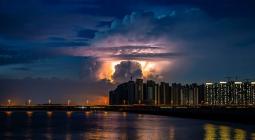War gave us the Red Cross. Now climate disaster means we need a Green Cross too
As floods, fires and storms escalate, it’s time for a body with the expertise and resources to protect people and the plane
In 1859 a Swiss businessman, Jean-Henri Dunant, travelled to northern Italy to discuss his investments in Algeria with the French emperor. The business meeting took place near the site of the battle of Solferino – a key confrontation in the war of Italian independence. Moved by the carnage and the sight of 40,000 wounded soldiers, abandoned on the battlefield, Dunant decided to dedicate his life to bringing humanitarian relief to war zones.
He was surprisingly effective. Thanks to his initiative, in 1863 the Red Cross was established, soon to be joined by the Turkish Red Crescent. In 1864, representatives of the main European powers signed the first Geneva convention “for the amelioration of the condition of the wounded in armies in the field”. In 1867 Dunant declared bankruptcy, his business interests entirely eclipsed by his philanthropic devotion.
The idea behind the Red Cross was simple but revolutionary: not even war should trample over common humanity. However vicious the conflicts between nations, the care and welfare of the wounded imposes a duty of cooperation on the belligerents.
Could a similar principle now be applied to the victims of climate disasters?
Whether flooding or droughts, cyclones or mega-fires, the climate crisis is leading to an exponential rise in the number of natural disasters and in the number of people affected by them. According to the UN, climate catastrophes have increased five-fold over the past 50 years, while the US recently set a new record for the number of billion-dollar calamities in a single year. Even under the most optimistic scenarios, these trends will continue for the near future.
Countries have very different capacities for aiding their populations when disasters strike, while the consequences of climate breakdown disproportionately affect lower-income countries. The loss and damage fund agreed at the Cop28 meeting in Dubai recognises this. And so here is a complementary idea: if there is a Red Cross, founded to support people affected by armed violence, why can we not found a Green Cross for those affected by climate disasters?
True, offers of international help are often extended quickly after earthquakes or catastrophic floods. But these are limited to great disasters such as the Libya floods of September 2023, operate on an ad-hoc basis and lack any established coordination capacity between different national rescue teams. They can also fall prey to national rivalries.
Imagine instead a planetary civil protection force with rapid-reaction capacities and clear operational expertise guaranteed by regular joint training and funding. When wildfires strike in the north of Africa, nearby teams from Europe, the Middle East and sub-Saharan Africa could jump in knowing exactly what to do. When flooding wreaks havoc in south-east Asia, Chinese, Indian and Australian corps would know how best to coordinate relief.
Just like the International Committee of the Red Cross, this body could be independent of any one country but draw its funding from both public and private sectors, working with professional national rescue teams and volunteers. It would provide tangible security and a modicum of equity between nations, guaranteeing a minimum common standard of protection for all the world’s inhabitants. Think of it as a limited planetary disaster insurance.
We have early templates of what such an initiative might look like. The European civil protection mechanism pools resources from all EU member states plus 10 non-EU countries to coordinate the deployment and delivery of assistance in the event of disasters in participating countries. In North America, firefighters in California and Canada already help one another to tackle mega-fires.
The benefits of coordination would far outweigh the bureaucratic costs of structured cooperation. In fact, we do this already for our military defence. Many countries organise joint military exercises to guarantee the interoperability of their forces: why should we be more cooperative in the application of violence than in the protection of life?
A planetary civil protection body could eventually expand from climate disaster relief to the preservation of nature. During the Great Depression in the 1930s, Franklin D Roosevelt established the Civilian Conservation Corps to enlist unemployed people to work in developing the country’s national parks and to conserve its forests. Could we not imagine a similar conservation corps enlisting young people from across the world in the protection of their common home?
Ultimately, a global initiative of this kind would do more than materially protect the world’s inhabitants: it would foster a much-needed feeling of common belonging to a shared, endangered planet. The Red Cross was born on the battlefields of northern Italy. As military and economic confrontations increase around us, isolating people while our planet burns, the world cries out for initiatives that weave together a common humanity. A civil protection force for the planet would represent a limited but concrete place to start.
Cover photo: Egyptian rescue workers in Derna, Libya, September 2023. Photograph: Zohra Bensemra/Reuters




